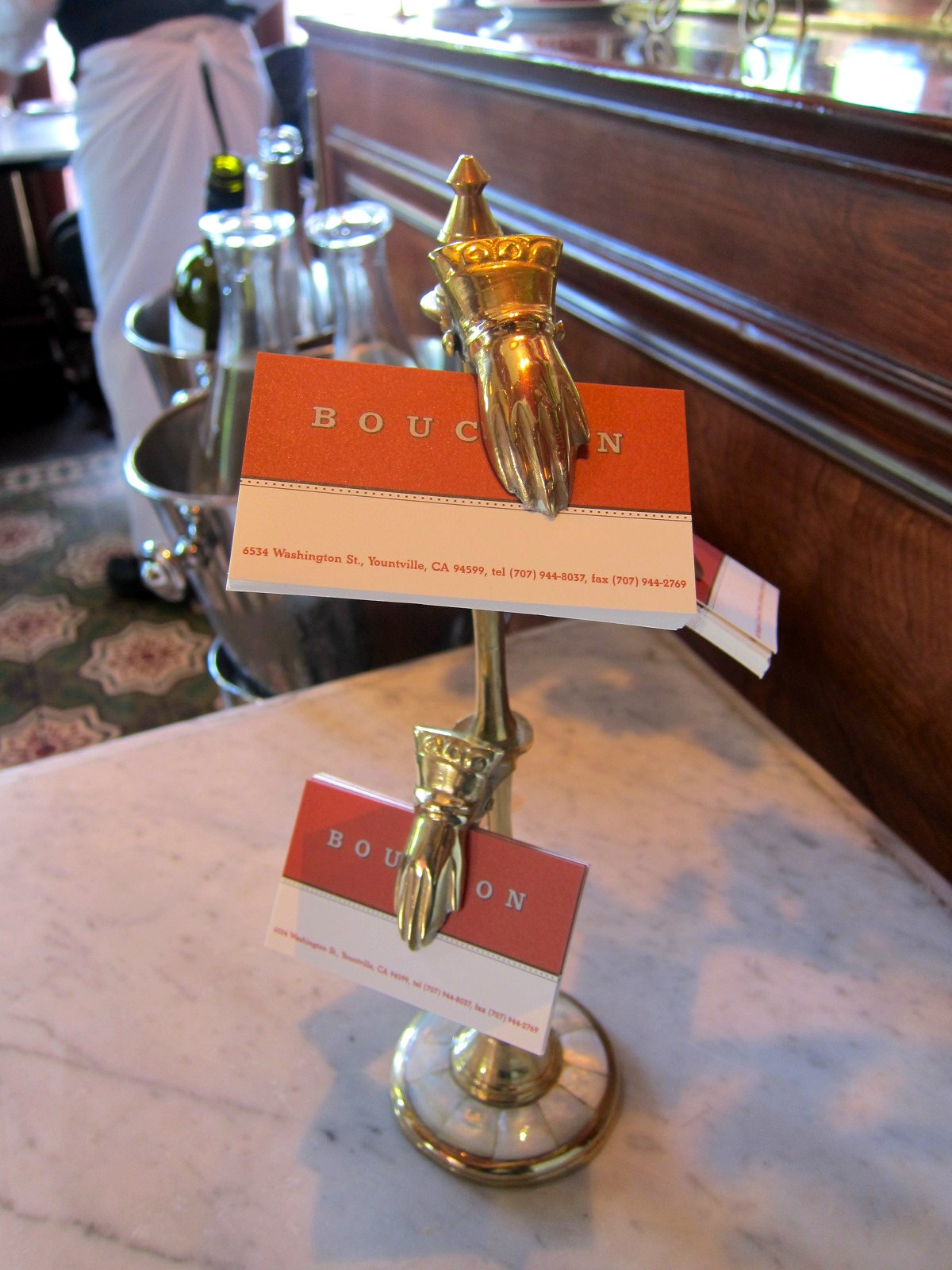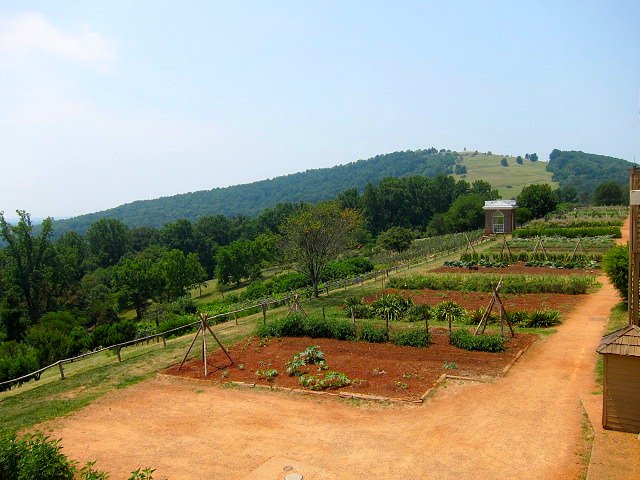A whimsical presentation of Bouchon's business cards
Photo: Chronica Domus
Nota bene: I had meant to publish this post in mid-April, but it somehow got buried within the other posts I am working on. I hope you enjoy it.
It was a crisp Saturday morning in the city, dampened by a light mist, and with just enough of a chill to warrant the use of a jacket. Forgoing the usual Saturday morning routine of stopping by the farmers' market and stocking up on the week's supply of vegetables and fruits, I decided instead that an escape to the country would be the order of the day. It had been several month since last visiting the Napa Valley so the three of us hopped into the family car and away we drove, across the Golden Gate bridge, and onto pastures green and yellow.
I adore visiting the environs of Napa at any time of year but I especially savor the drive during the early spring months. To witness firsthand the swathes of vibrant mustard yellow flowers of rapeseed that blanket the landscape as far as the eye can see is a special privilege indeed. It really is quite a sight, depending on whether your timing is impeccable, of course. Unfortunately, on this particular journey, we just caught the tail end of the show as there were fewer flowers to woo us than in years past. However, dotted about here and there were dazzling orange poppies, California's state flower, punctuating the green hills and pastures. Nature certainly knows how to put on a spectacle in spring, no matter the color.
Grapevines and green hills everywhere you look
Photo: Chronica Domus
Meandering along the tree lined highways dotted with wineries and neat rows of grapevines, one felt an overwhelming sense of pleasure that everything was right with the world. How could it not be? This is truly one of the most spectacularly picturesque places in the entire Bay Area, a place already saturated with much natural beauty; a jewel polished off with a favorable climate, world-class viticulture, exceptional culinary experiences attained through sensitive agricultural practices, and picture perfect towns. This must surely be what Eden on earth looks like. Well, at least in this corner of the world certainly.
The exterior of Bouchon housed in an historic brick building
Photo: Chronica Domus
Approaching 1 p.m., with warnings from grumbling tummies, we stopped for lunch in Yountville, a little town that is home to a rather large star of the restaurant world. Our destination on this occasion was
Bouchon, Thomas Keller's little bistro, just a few minutes walk from his other more famous landmark restaurant,
The French Laundry. You may already know of Mr. Keller as he has received some of the highest accolades awarded to any American chef, and his restaurants, including New York's
Per Se, are perennial favorites on the world's top restaurant lists.
Bouchon, opened in 1998, is Mr. Keller's little Parisian-esque outpost where one can dine very well on honest French bistro fare, served at either lunch or dinner, without enduring months of wait for a table (I hear there is a six month lead time for dinner reservations at The French Laundry). On this occasion, we were fortunate to have been seated within a few minutes of our arrival, with no prior reservation, at an already packed restaurant.
The beautiful zinc-lined bar displaying a selection of the day's Fruits de Mer
Photo: Chronica Domus
Bouchon is housed within a brick building constructed in the 19th century, and is fronted by an outdoor seating area, of which many diners chose to take advantage. The indoor dining room is flooded by a profusion of natural light that streams through the floor-to-ceiling casement windows and by the multitude of mirrors lining the walls. At the center, the space is anchored by an enormous lush potted palm. Our table was located besides the palm which afforded us an excellent view of the lively and energetic comings and goings of the busy dining room. A very attractive zinc-lined bar, stocked with the usual top shelf spirits and a variety of locally produced wines, dominates the corner opposite the entrance. The bar also doubles as a showcase for tempting marine treats on offer. So, if oysters, lobsters, crabs, mussels, and shrimp are your thing, you've no doubt come to the right place.
The enormous potted palm reaches for the ceiling
Photo: Chronica Domus
For us, every successful lunch begins with a round of refreshing gee and tees, and that is precisely what we ordered to kick off the proceedings. Our daughter, of course, is not yet of drinking age so appropriately chose a suitable beverage befitting her years. Wisely, we decided against ordering a second round of gee and tees, as we were, after all, in the heart of wine country and would have hated to forgo the opportunity of sampling a great locally produced white or red with our meal. How funny to think back to the days before moving to America when I was completely in the dark about California's world-class wines. My family in England always favored wines from France, Germany, Spain, and Italy, so I had foolishly assumed anything beyond the old world would be of no match. So, it was with much joy and pleasure that I discovered the delights of the Napa Valley, just a short distance from my new home, through the numerous tastings at wineries over the years. The region has produced wine since the 1850's and is now considered one of the premiere wine regions of the world.

Gee and tee at the ready, menu to hand, and crusty pain d'epi to munch upon
Photo: Chronica Domus
Bouchon's menus are printed on brown paper and are to be found at each place setting, folded over the fresh cloth napkins. Our efficient and friendly waiter, traditionally dressed in a long white apron, black waistcoat and tie, was quick to point out the day's specials, one of which immediately caught our attention. The menu is seasonally focused, but the backbone of bistro fare dominates; steak frites, steak tartare, escargot, duck confit, salads, vegetable dishes, and soups.
As asparagus is currently at its peak, sourced locally from the Sacramento-San Joaquin river delta, we ordered the salade d'asperges which looked very artful as it arrived on its plate, accompanied by a melange of spring vegetables in a light vinaigrette. Perfectly tender yet still crisp, it was a delicious start to our luncheon.
A picture perfect presentation of asparagus
Photo: Chronica Domus
My husband and daughter rather fancied the coddled eggs, one of the special dishes of the day, and who could blame them. It must have been a popular choice among today's hungry diners because as soon as our order was taken, the waiter erased it from the slate of specials. I enjoy a good decadent egg dish and this one had me wavering between it and the trout. Served in little iron lidded cocottes, the eggs were faultlessly cooked, bathed in rich cream, fresh herbs, spinach, mushrooms, and chunks of Maine lobster, with a surprise bread-like pastry bottom. I could not help but swipe a few bites from my daughter who enjoyed the dish immensely and has developed quite a mature palate for a twelve year old.
Sublimely prepared coddled eggs with Maine lobster, spinach and mushrooms
Photo: Chronica Domus
I selected the slightly less calorific rainbow trout with haricots verts and toasted almonds in brown butter, and immediately counteracted the effects of my somewhat healthy choice with an order of pommes frites. How do those elegant French ladies stay so stick-slim I wonder? The accompanying aioli did not help my cause, but oh my heavens, how delicious it all was!
Delectably fresh trout heaped with haricots verts and toasted almonds
Photo: Chronica Domus
Carafes for water and wine stand to attention in their ice buckets
Photo: Chronica Domus
Of course, no French diner would think it civilized to dine sans a glass or two of wine, and here in the heart of wine country, we were spoilt for choice. Both French and local wines were offered so we opted for the local experience with a refreshing glass of
Hartwell's sauvignon blanc, and a nicely polished zinfandel blend produced by
Ridge Vineyards. Both choices were perfect accompaniments to our meals.
In hindsight, we all agreed that perhaps we should have dismissed the thought of dessert and settled for coffee. When given the option, however, we weakened rather swiftly and ordered profiteroles, which resembled little French berets atop ice cream balls (more Americanized than French), and a divinely zippy tarte citron.
A perfect ending: Lashings of rich chocolate sauce drizzled over profiteroles
Photo: Chronica Domus
A refreshingly zesty tarte citron
Photo: Chronica Domus
What a relaxing time we were having ensconced in an establishment that could have just as easily been situated on the Left Bank were it not for the inimitable tell-tale California sunlight illuminating the room. Sitting here, sipping our coffee and reminiscing over lovely past lunches shared in the bistros of Paris, made us yearn to once again visit that grandest of cities in the spring.
If you find yourself in the beautiful and serene Napa Valley and are hankering for exquisitely prepared and deliciously tasty French food, do give Bouchon a try. Mr. Keller has done an admirable job of incorporating the best of the region's abundant farm-to-table ingredients into classic French bistro cuisine. Oh, and you could always take home dessert (as we probably should have), from the bistro's bakery right next door. You will easily locate it. Just follow the winding queue and wait patiently to be served the perfect slice of tarte, a crusty pan d'epi, or a croissant or two. Bon app
étit!
Nota bene: I am neither paid nor do I receive
recompense in exchange for applauding products or services within my
blog. I do so because I enjoy them. If you are a kindred spirit, you
too enjoy recommending nice things to fellow good eggs.


























